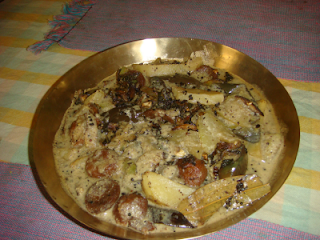First I need to confess that the idea of this reference section is not mine. This was started by my uncle, (Pranam Roy) in Facebook where he requested all his friends to name 3 of their favorite eating joints of Kolkata. He was particular to mention that we should not name the posh or expensive restaurants. Only the local, roadside joints that draws thousands and thousands of Kolkattans everyday. I have taken all of them and made a foodictionary for all the eateries. This is the English version. Click here for the Bengali version. You are free to add yours. You can mail me at: kolkatakuisine@gmail.com or simply leave a comment. I will add your favorite in the list.
Reference List: (A - Z)
Reference List: (A - Z)
A
• Arsalan biryani
• Sharma’s beside Ashutosh College
• Anadi’s moghlai porotha – it’s so soft that it melts in your mouth. They give a spicy potato curry with that. Awesome.
• Aminia (Esplanade) =Tandoori roti and Chicken curry
B
• Bobo Shambo VP’s phuchka walla
• Bedwin’s fish roll
• Bhawanipur Sharma's Kachauri
• Fowl cutlet of Chacha's on Beadon Street
• Benfish eatery[Open air] at karunamoyee, fried-rice[35-40Rs], gravy chowmin etc.]
• Bura Bazar’s Lassi
• Bhojohori Manna
• Benfish’s Fish fry,
• Bijoli grill’s fish fry
• Bancharam’s sweets
D
• Decker's lane - Chittoda’s toast & chicken stew
• Deshapriyo Park - Maharaja or Maharani’s Kachauri-aalu sabji with jalebi
• Dacre's Lane’s - Ruti & Mutton Stew
• Beside Deshopriyo Park Bus Stand - Mashima's Ghugni (simple Ghugni / Mutton Ghugni)
E
• Elgin Road Gurudwara - Dhaba Tea...
• Esplanade - cholle batore
• Exide - momo
• Esplanade - MANGO LASSI
• Ekdalia - Tasty corner’s Kachauri
• Eliot Road - Suruchi's Lau-chingri (lauki with prawns), Ilish Shorshe (hilsa in mustard curry paste), etc
• Esplanade - Rallis Kulfi-Phaluda & Firni. In fact any sarbat
• Exide - Haldiram’s Chinese bhel
G
• Gariahat - Campari’s roll,
• Gangotri[AC] at CF block veg cutlet (10Rs) coffee(10Rs)
• Gariahat - Das Cabin Moghlai Paratha
• Gariahat – Sonali’s masala dosa...
• Grub club at Gol Park
• Golbari’s kasha mangsho r ruti (spicy dry mutton with phulkas)
• Gariahat - Bedwin’s double egg double mutton roll
H
• Hajra - Biryani (1/2 plate )
• Haji Saheb’s Roll and other Biriyani stuffs
J
• Back of Jadavpur 8B Bus-stand - Phuluri & Tele-Bhaja (fried pakoras)
K
• Mutton roll at Karnani Mansion
• Kidderpore - Bread & Kosha Maangsho (spicy dry mutton)
L
• Lord Sinha Road - Mayaram's Paw Bhaji,
• Lake Market - Komala Villa’s South Indian Thaali
• Lake Market - Radu babu’s Chicken Kabiraji and tea
M
• Mandevilla Gardens - Tasty Corner’s Radhaballavi (daal puri), alurdom (dum aalo), kachauri
N
• New Market - Nizam's - jeta khaabe sheta
• New market - phuchka,
• New Market - Nahoum’s cakes and breads
P
• PARK CIRCUS - ROLL CORNER
• Park street. - Hot Kati Roll
• Purno Cinema - Sangu-Valley'te Fish Kobiraji
• Paramounter sorbot (specific dab sorbot)
• Princep Ghaat - Pav bhaji
• Peep-n-Inn Roll
R
• Royal = Chicken chap
• Rashbehari - Punjabi Dhaba's Tandoori Roti & Butter Chicken
• R. N. Mukherjee Road – In front of Birla House “Chilla-Chutney”
• Rabindra Sadan - momo
S
• SHREEHARI ‘s KACHORI
• Scoop[AC} opposite to salt lake swimming pool: As you like it ice cream 5 scoop of icecream with lot of cashew nut dry fruits etc.[130Rs], momo[70Rs],sandwitch[60-70Rs], funky roll[35Rs]
• South calcutta - (mind it not kolkata) bhabanipur cabin’s Kobiraji cutlet with kasundi (Indian mustard sauce)
• Saltlake Karunamoi – bapida’s chicken fry
• Shiraz-r Biriyani
• South Indian Club (Purnadas road) Masala Dosa, Mysore Bonda
T
• Tiwari brothers’ lassi
• Triangular park – Minibox’s hakka chowmein;
U
• Vadas at Udipi
V
• Vivekananda Park - Puchka, Dahi-Phuchka, Alurdom phuchka; & Batata-Puri.
• Vaardhan market - Pav Bhaaji
Z
• Zeeshan Tikia Roll






 Prawn
Prawn










